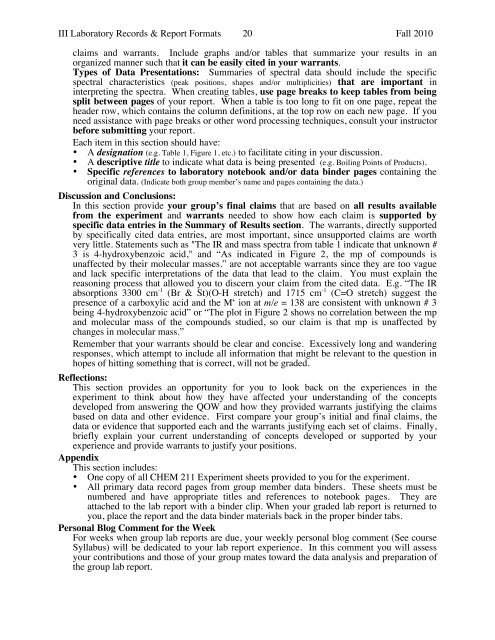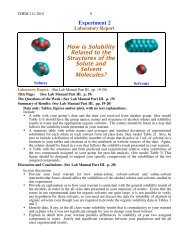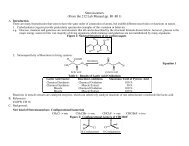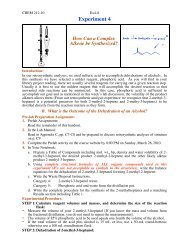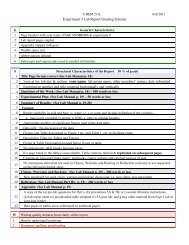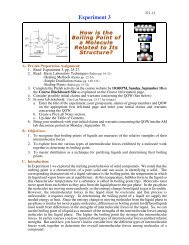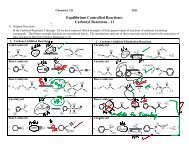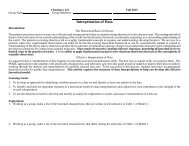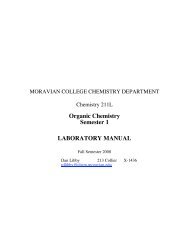Organic Chemistry Semester 1 LABORATORY MANUAL - Moravian ...
Organic Chemistry Semester 1 LABORATORY MANUAL - Moravian ...
Organic Chemistry Semester 1 LABORATORY MANUAL - Moravian ...
Create successful ePaper yourself
Turn your PDF publications into a flip-book with our unique Google optimized e-Paper software.
III Laboratory Records & Report Formats 20 Fall 2010<br />
claims and warrants. Include graphs and/or tables that summarize your results in an<br />
organized manner such that it can be easily cited in your warrants.<br />
Types of Data Presentations: Summaries of spectral data should include the specific<br />
spectral characteristics (peak positions, shapes and/or multiplicities) that are important in<br />
interpreting the spectra. When creating tables, use page breaks to keep tables from being<br />
split between pages of your report. When a table is too long to fit on one page, repeat the<br />
header row, which contains the column definitions, at the top row on each new page. If you<br />
need assistance with page breaks or other word processing techniques, consult your instructor<br />
before submitting your report.<br />
Each item in this section should have:<br />
• A designation (e.g. Table 1, Figure 1, etc.) to facilitate citing in your discussion.<br />
• A descriptive title to indicate what data is being presented (e.g. Boiling Points of Products).<br />
• Specific references to laboratory notebook and/or data binder pages containing the<br />
original data. (Indicate both group member’s name and pages containing the data.)<br />
Discussion and Conclusions:<br />
In this section provide your group’s final claims that are based on all results available<br />
from the experiment and warrants needed to show how each claim is supported by<br />
specific data entries in the Summary of Results section. The warrants, directly supported<br />
by specifically cited data entries, are most important, since unsupported claims are worth<br />
very little. Statements such as "The IR and mass spectra from table 1 indicate that unknown #<br />
3 is 4-hydroxybenzoic acid," and “As indicated in Figure 2, the mp of compounds is<br />
unaffected by their molecular masses.” are not acceptable warrants since they are too vague<br />
and lack specific interpretations of the data that lead to the claim. You must explain the<br />
reasoning process that allowed you to discern your claim from the cited data. E.g. “The IR<br />
absorptions 3300 cm -1 (Br & St)(O-H stretch) and 1715 cm -1 (C=O stretch) suggest the<br />
presence of a carboxylic acid and the M + ion at m/e = 138 are consistent with unknown # 3<br />
being 4-hydroxybenzoic acid” or “The plot in Figure 2 shows no correlation between the mp<br />
and molecular mass of the compounds studied, so our claim is that mp is unaffected by<br />
changes in molecular mass.”<br />
Remember that your warrants should be clear and concise. Excessively long and wandering<br />
responses, which attempt to include all information that might be relevant to the question in<br />
hopes of hitting something that is correct, will not be graded.<br />
Reflections:<br />
This section provides an opportunity for you to look back on the experiences in the<br />
experiment to think about how they have affected your understanding of the concepts<br />
developed from answering the QOW and how they provided warrants justifying the claims<br />
based on data and other evidence. First compare your group’s initial and final claims, the<br />
data or evidence that supported each and the warrants justifying each set of claims. Finally,<br />
briefly explain your current understanding of concepts developed or supported by your<br />
experience and provide warrants to justify your positions.<br />
Appendix<br />
This section includes:<br />
• One copy of all CHEM 211 Experiment sheets provided to you for the experiment.<br />
• All primary data record pages from group member data binders. These sheets must be<br />
numbered and have appropriate titles and references to notebook pages. They are<br />
attached to the lab report with a binder clip. When your graded lab report is returned to<br />
you, place the report and the data binder materials back in the proper binder tabs.<br />
Personal Blog Comment for the Week<br />
For weeks when group lab reports are due, your weekly personal blog comment (See course<br />
Syllabus) will be dedicated to your lab report experience. In this comment you will assess<br />
your contributions and those of your group mates toward the data analysis and preparation of<br />
the group lab report.


